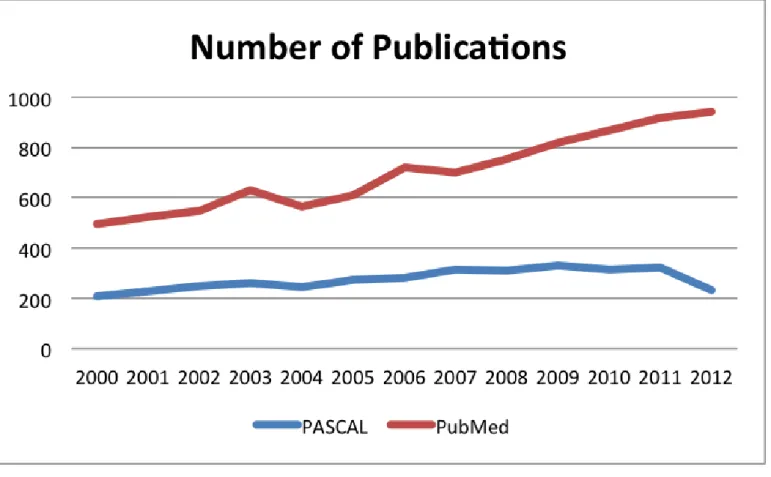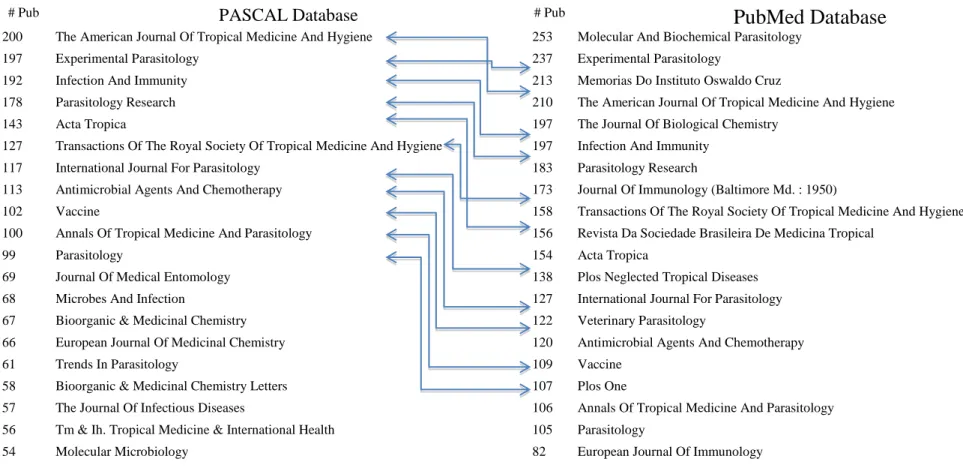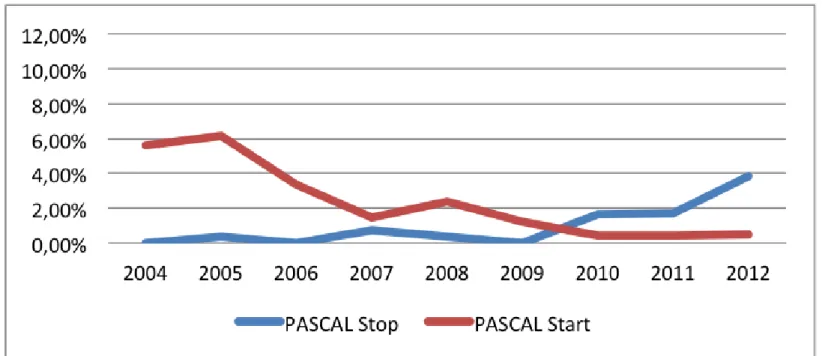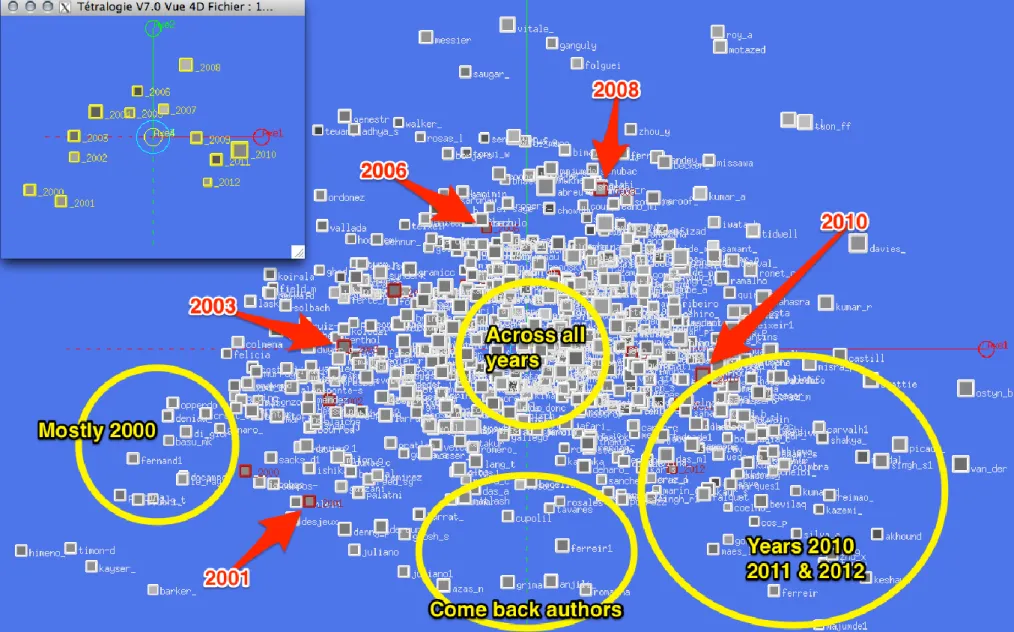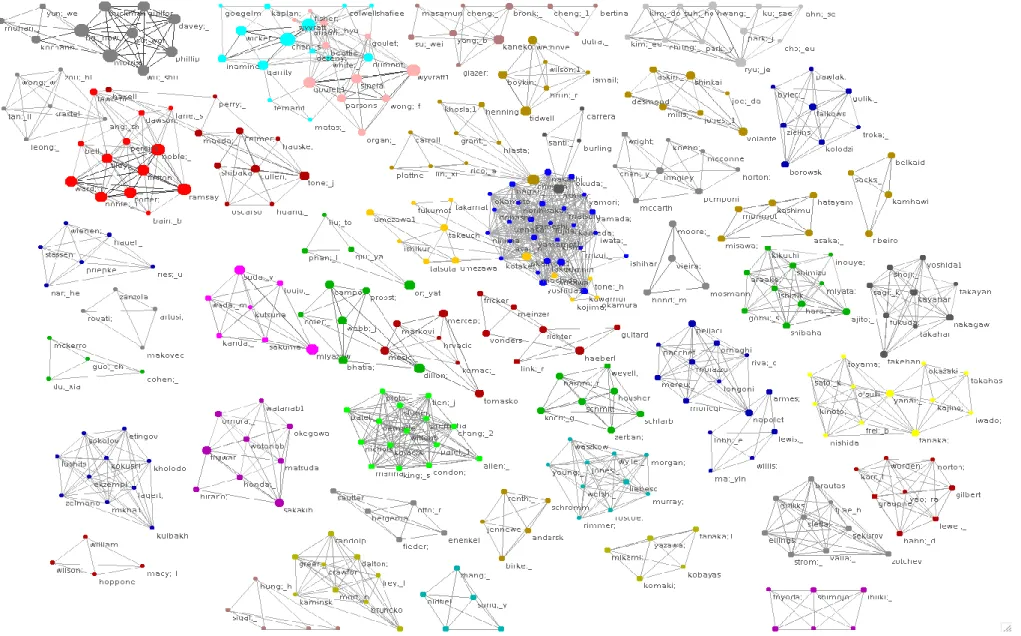OATAO is an open access repository that collects the work of Toulouse
researchers and makes it freely available over the web where possible
Any correspondence concerning this service should be sent
to the repository administrator: tech-oatao@listes-diff.inp-toulouse.fr
This is an author’s version published in: https://oatao.univ-toulouse.fr/22142
To cite this version:
Barros Sampaio, Ricardo and Dousset, Bernard and Gay, Brigitte A
comparative study between scientific publications and patents: a
case of a neglected disease, Leishmaniasis. (2013) In: Colloque
International V.S.S.T.’2013 : Veille stratégique scientifique &
technologique, 23 October 2013 - 25 October 2013 (Nancy, France).
(Unpublished)
A comparative study between scientific publications and patents: a case of a neglected
disease, Leishmaniasis
Ricardo BARROS SAMPAIO (*, **), Bernard DOUSSET (***), Brigitte GAY (****),
rsampaio.br@gmail.com, bernard.dousset@irit.fr, b.gay@esc-toulouse.fr(*) Universidade de Brasilia - UnB (Brasil) ; (**) FIOCRUZ Brasilia (Brasil)
(***) IRIT Université Paul Sabatier, Toulouse (France) ; (****) Ecole Supérieure de Commerce de Toulouse (France)
Mots clefs : Veille scientifique et technologique, bibliométrie, graphes, réseaux sociaux, géostratégie, visualisation, interactivité, maladies
négligée, leishmaniasis
Keywords: Scientific and technological vision, bibliometrics, graphs, social networks, geo-strategy, visualization, interactivity, neglected
diseases, leishmaniasis
Palabras clave : Vision científica y tecnológica, bibliometría, gráficos, redes sociales, geo-estrategia, visualización, interactividad, enfermedades
negligenciadas, leishmaniasis
Résumé
L'objectif principal de cette recherche était de mettre en avant des méthodes qui pourraient aider et nourrir les gestionnaires de la santé de prendre des décisions sur les maladies négligées et les plus précises sur la leishmaniose. Le présent ouvrage est une étude comparative évaluer les facteurs présentés dans un environnement de recherche à travers l'analyse des publications scientifiques et dans le secteur de la santé à travers l'analyse des brevets et comment ces deux zones sont reliées entre elles, le cas échéant. Au cours de cette recherche, nous avons appliqué des méthodes de données et d'analyse des réseaux sociaux dans la recherche, le traitement et l'analyse de ces informations et des réseaux en évaluant les relations entre les entités, les chercheurs et les brevets au fil des années. La dernière tentative de ce travail était de cartographier les intérêts sur la leishmaniose parmi les pays du monde et de sa dynamique sur les 13 dernières années.
Abstract
The main objective of this research was to bring forward methods that might help and nourish health managers take decisions about neglected diseases, and more specific on Leishmaniasis. The present work is a comparative study evaluating factors presented within a research environment through the analysis of scientific publications and within the health industry through the analysis of patents and how those two areas are interconnected, if so. During the course of this research we applied methods of Data and Social Network Analysis in the search, treatment and analysis of such information and networks by evaluating the relationships between the entities, researchers, and patents along the years. The last attempt of this work was to map the interests on Leishmaniasis among the countries in the world and its dynamics on the past 13 years.
1 Introduction
The research universe defined for this study is on Leishmaniasis disease contained in the so-called neglected tropical diseases (NTD). The term NTD, which has been used since the mid 1990s, has become a ―brand-name‖ referring to a group of diseases that are especially endemic in low-income populations living in tropical and subtropical countries (Ramos, Gonzalez-Alcaide, e Bolanos-Pizarro 2013). However, up to this date, there are no clear or agreed definitions for what constitute a neglected disease. According to the 2010 report from the World Health Organization (WHO) ―Working to Overcome the Global Impact of Neglected Tropical Diseases‖ the NTDs affects more than 1 billion people around the world.
The known diseases are defined by the WHO as types I, II and III where Leishmaniasis is considered a type III disease. This definition is followed by a great number of health organizations and ministries around the world. The definition in itself mixes a number of concepts together including the wealth of a country between rich and poor; the state of its development between developed and developing and most importantly a measure of the burden of diseases by the incidence of the disease within the population (CEWG 2012). The definitions themselves are combined such that:
Type I diseases: are incident in both rich and poor countries, with large numbers of vulnerable populations in each.
Type II diseases: are incident in both rich and poor countries, but with a substantial proportion of the cases in poor countries. Type III diseases: are those that are overwhelmingly or exclusively incident in developing countries.
With regard to investments in the area, those diseases do not receive adequate attention for its treatment and eradication, which perpetuates the condition of people who are exposed to them (Morel et al. 2009). In order to treaty the problems involved with NTDs, or Leishmanisis specifically, it is necessary to understand its complexity. One of the ways to help this situation through research is to provide methods to analyze the context using a number of different instruments and approaches. The study of scientific publications and patents is part of what is involved and this present work intends to show some of its benefits.
In regard to scientific publications, there are a number of databases that catalogue journals on specific areas. Those databases are a very rich environment to understand the research world with information such as countries involved on research, number of publications per year and collaboration among institutions, countries and researchers. However, due to the large number of publications, journals and databases it is necessary to define clear methods that can bring valuable information at the right time. The analysis of patents is also used to measure and understand the growth or declined interest of countries and organizations within the NTD context. Through its analysis a great number of information might surface, such as companies and research institutions involved, countries health and economical policies and others.
A number of publications on co-authorship and patents on NTDs specific diseases have been published in recent years. It‘s imperative that new tools and approaches being developed focus on facilitating public policy planning and foster the management of innovation in countries‘ public health systems (Vasconcellos and Morel 2012). On Leishmaniasis a recent bibliometric study (Ramos, Gonzalez-Alcaide, e Bolanos-Pizarro 2013) used one of the databases included in our work, helping making a comparison of the results. One of the results found was that the number of publications on the area has increased considerably on past years. A comparison with results from another research (Newman 2004) has also been made in regards to the same database using a co-authorship analysis.
2 Data Analysis of a Neglected Disease
The research universe on Leishmaniasis for this paper has been made through the analysis of two different databases, PubMed and PASCAL, for scientific publications and one agency, The United States Patent and Trademark Office (USPTO) for patents and patent‘ applications. The reason behind the use of two different databases on scientific publications was to analyze if there were significant differences that might bias ones research. The access to the databases occurred during the month of May and June, 2013. We have decided to take into consideration only the publications and patents from 2000 to 2012 included.
2.1 Method for Data Treatment
For the data treatment and analyses we used the software Tetralogie. The software allows (several and remote users) to conduct strategic analysis from heterogeneous textual data through analysis of conventional and innovative methods. With statistical methods and exploratory data analysis methods, it shows strategic information such as actors identity, mobility, emergence and evolution of topics, concepts and terminology. Another feature of the software is that it allows graphical visualization for understanding human activities and their interactions as well as their evolution in a decision-making perspective. It combines static and dynamic visualization where the static aspect is based on a representation space, in which the precepts of graph theory are applied. The dynamic visualization applies features and capabilities to further understand evolution of the data and facts in respect to time. Tetralogie allowed us to identify the role of data within the structure, analyzing their neighborhood, filtering, k-core, transitivity, back to the source documents, to partition the graph or to focus on its structural features.
2.2 Database
The research have been made taking into consideration authors of articles and patents, countries where those authors were from, journals used for the scientific publications besides companies, universities and research institutions involved on both articles and patents. For all the information analysed the years of publication for scientific publications and of deposit for the patents were added to the analysis in order to understand the dynamics of the area within the past 12 years. The PubMed platform, which holds the Medline Database, was used for the research as one of the databases. PubMed is a free database accessing references and abstracts on life sciences and biomedical topics. Data files were retrieved from PubMed with the Medical Subject Headings (MeSH) terms or descriptors ―Leishmaniasis‖ and ―Leishmania‖ for title and abstract, for the years 2000 to 2012. The second database used for the scientific publications was PASCAL. Pascal is a multidisciplinary and multilingual bibliographic database. It covers most of the world literature in Science, Technology and Medicine since 1973. The same search terms, dates and review of the data applied to PubMed was applied to PASCAL. After reviewing the data we decided to discard all the articles which contained the word ―clinical‖ explicitly on their titles or abstracts. We decided for this path on the bases that clinical trials is a post discovery phase which might bias the understanding of innovative contribution on the area and the consequent interest of scientific community and corporations. For the patents we have used the USPTO web site for the data retrieval. The search terms used had the same characteristics as for the scientific publications plus the medicines used to treat the illness as stated on the United States National Institute of Health (NIH) web site (http://www.ncbi.nlm.nih.gov/ access june 2013); sodium stibogluconate, meglumine antimoniate, macrolide, benzamidine, phosphorylcholine and neomycin.
2.2.1 PubMed and PASCAL scientific publications
The scientific databases are both well known and largely used by the academic community. Their differences however could help future researches taking into consideration aspects that might be important for more precise studies. The total number of publications between both databases diverge almost 3 folds for
PubMed having a total of 9,210 articles for the period with the filtering mentioned before against 3,650 publications in PASCAL. The total number of Journals has also a great difference with PubMed covering 1,114 journals while PASCAL covers 362. This difference suggests that PuBMed has a much higher coverage in terms of absolute numbers. However, PASCAL has a more detailed qualification of the data concerning the countries where the authors are coming from. This is an important information if ones research aims to understand which countries are making the most contribution and the cooperation existent on research world. A slight difference in regards to country publications rank was noticed on the total number of articles per country, where USA, France, Belgium, Tunisia and Turkey had one or two places higher ranked in PASCAL, while Italy is 5 times lowered ranked. We also analyse the average of information per article concerning MESH words and key words but it was not found any significant difference among the databases.
2.2.2 Patents
For the patents we used the USPTO database, retrieving data for patents that has already been published as well as patents applications. The total number of patents and applications found were respectively 810 and 680. The number of authors for those patents and applications were respectively 1,610 and 1,435. We will discuss further on how those authors interact with each other showing a clear difference from collaboration in comparison to academic researchers. In respect to the number of companies or organizations whom own the patent there are further analysis that must be done in regards to the applications, which shows in most cases not the owner but its legal representative. In total there were 332 different organizations for the patents and 217 for the applicants. Out of those organizations 15 of them have 5 or more patents and 9 of them has 5 or more applications with United States, Japan and Germany alone with more than 50% of all the patents and applications on the area.
3 Results
One of the results of our study was the absolute number of publications for each database per year as shown on figures 1 and 2. Figure 1 shows a steady increase for the scientific publications with a greater ratio for PubMed in comparison to PASCAL. For the year 2012 the PASCAL data shows a decrease in numbers of publications compared to 2011, however this might happen due to a delay on the processing of new publications. This difference for the year 2012 for PASCAL database deserves a further study. As for the patents and patents‘ applications there was an increase on the years 2000 to 2003 with a clear drop and further fluctuation for the following years. After 2005 there is a downturn over the patents and applications on the area. However, due to a processing delay for patents, which might take from 2 to 12 years in some cases, the actual numbers of approved patents might change significantly.
The comparison between the two areas, academic and commercial, brings a view over the interest in Leishmaniasis research and production. Because neglected diseases over past years has shown not to bring great revenue for pharmaceuticals corporations, in comparison to other areas, the numbers of patents and applications might have decreased as a consequence. On the other hand, the problem for developing countries and the number of people affected by those illnesses has forced emerging countries such as Brazil and India to invest on scientific research. Another very important player on the area are the Non Governmental Agencies (NGO), such as Medecins Sans Frontiers (MSF) and Drugs for Neglected Diseases initiative (DNDi), which has helped bring lowered prices medicines and treatments for the needs.
Figure 1 – Total Number of Scientific Publications
Concerning the journals used by the researchers for publications the 20 most frequent journals in PASCAL where found amongst the first 30 journals in PuBMed. On the other hand, out of the 20 journals most used by researchers on PubMed only 9 were found amongst PASCAL database. A list of the first 20 journals for each database is shown on table 1 with the numbers of publications for the period analyzed on the left column. Noticed that the first journals on PASCAL database, marked with the arrowed lines, are all present on PubMed but it doesn‘t hold true for the other way around.
Figure 2 – Total Number of Patents and Patents Applications
The study of the journals and its publications might help understand the interest that the journals might have. For the purpose of this study we concerned ourselves with the absolute number of publications in order to understand the increase or decrease of interest over the years. We have not used the impact factor for each journal in this study because we understand that there is a further analysis that might be necessary. This analysis is concerned with the characteristic of each journal. Some journals want to be on the leading edge of scientific publications, other journals might start publications in a certain area only after a few years that a topic became settled among the scientific community. This type of study would help understand and better qualify journals.
Table 1 - Journals with most Publications from 2000 to 2012
# Pub
PASCAL Database
# PubPubMed Database
200 The American Journal Of Tropical Medicine And Hygiene 253 Molecular And Biochemical Parasitology 197 Experimental Parasitology 237 Experimental Parasitology
192 Infection And Immunity 213 Memorias Do Instituto Oswaldo Cruz
178 Parasitology Research 210 The American Journal Of Tropical Medicine And Hygiene 143 Acta Tropica 197 The Journal Of Biological Chemistry
127 Transactions Of The Royal Society Of Tropical Medicine And Hygiene 197 Infection And Immunity 117 International Journal For Parasitology 183 Parasitology Research
113 Antimicrobial Agents And Chemotherapy 173 Journal Of Immunology (Baltimore Md. : 1950)
102 Vaccine 158 Transactions Of The Royal Society Of Tropical Medicine And Hygiene 100 Annals Of Tropical Medicine And Parasitology 156 Revista Da Sociedade Brasileira De Medicina Tropical
99 Parasitology 154 Acta Tropica
69 Journal Of Medical Entomology 138 Plos Neglected Tropical Diseases 68 Microbes And Infection 127 International Journal For Parasitology 67 Bioorganic & Medicinal Chemistry 122 Veterinary Parasitology
66 European Journal Of Medicinal Chemistry 120 Antimicrobial Agents And Chemotherapy 61 Trends In Parasitology 109 Vaccine
58 Bioorganic & Medicinal Chemistry Letters 107 Plos One
57 The Journal Of Infectious Diseases 106 Annals Of Tropical Medicine And Parasitology 56 Tm & Ih. Tropical Medicine & International Health 105 Parasitology
54 Molecular Microbiology 82 European Journal Of Immunology
On tables 2 to 5 we show the number of publications for each database by year and per country. The first two tables, 2 and 3, shows the publications for PASCAL and PubMed. It can be seen that there is very few differences among the leading countries concerning the total number of publications with Brazil, USA, India, UK and France as the top 5 countries. In regard to the years we can see a steady increase in publications over the years, as shown also in figure 1, with a decrease for the year 2012 for PASCAL database.
Table 2 - PASCAL Number of publications by country and year Table 3 - PubMed Number of publications by country and year
Figures 3 and 4 show the data on tables 2 and 3 in a graph format without the total sum.
Figure 3 – PASCAL top countries Publications Figure 4 – PubMed Top countries Publications
The same data used on table 2 and 3 is showing on figures 4 to 5 in terms of publications and patents per country. The figures only show the sum over the 12 year period. The lighter the green the greater the number of publications and patents. The countries in red or orange have no recorded publication or patent on the databases used. This map can give an idea of how spread is the scientific publications and patents around the world.
Figure 5 – PASCAL – Global view of Scientific Publications Figure 6 – PubMed - Global view of Scientific Publications
As for the Patents and applications, the tables 4 and 5, we have both USA and Japan as the main countries with patents over the disease with countries in west Europe following those. Concerning the number of patents over the years we can‘t see an increase in interest over the area which diverges from the scientific community publications.
Table 4 - Number of Patent publications by country and year Table 5 - Number of Patent applications by country and year
3.1 Author Turnover
Another approach on our study have been done on author turnover for scientific publications attempting to understand how often there are new people coming in to the field and if experienced researchers are leaving to other areas of study. This analysis might show how settled an area of research is and how it brings interest for new scientists. In figures 6 and 7 we show the turnover with a cutoff point for authors with a minimum of 10 publications on the area over the 12 year period. If an author publishes an article after 4 years of not publishing on the area he is considered a new entrant or start. If an author, after publishing on the field stop publishing for at least 4 years, on the fifth year he is marked as leaving the field or stop. The graph shows that, out of all the authors with 5 or more publications on the area, 12% by the year 2005 on PubMed were entering the field, against 1% leaving the field for the same period. There is a clear pattern seen of both databases where in the begin of the period studied there were many new entrants then people leaving the field. This shows an influx of new people in the field for that period. The absolute number of new entrants has grown each year until 2009 for PASCAL and 2010 for PubMed. Since then there is a shift on the number of people entering and leaving the field.
Figure 8 – PubMed - Turnover authors with 10 or more publications
Figure 7 brings the same information for author turnover in a different view. The years, as shown in the top left part of the figure and pointed out in red on the bigger picture, show the years spread across the quadrants. The circles in yellow show the concentrations of authors which have published around those periods. A great majority of authors are in the field through out the entire period (centre of the graph) while others have written mostly around the year 2000, or around years 2010 to 2012 on leftmost and rightmost circles on the figure. The bottom circle show authors which have written in the begin of the period and have come back again on the last years. We can also see that the top right quadrant is the densest demonstrating a greater concentration of authors.
3.2 Social Network
Another line of research for the data collected for this work was the co-authorship on scientific publications and patents. People working together might demonstrate a type of relationship in which ―most people who have written a paper together will know one another quite well‖ (Newman 2001). However this might not hold true for all the cases. In our study we have found 3 papers with more than 100 contributors for PubMed and 2 papers with more than 60 contributors for PASCAL. Those high numbers might suggest that on some cases the researchers do not necessarily know each other ―quite well‖. Those articles with a high number of contributors are not the average, as the numbers of Authors per Article (6,24 and 5,47 for PubMed and PASCAL) have shown but must be taken into consideration, specially when reviewing the clustering coefficient (Watts e Strogatz 1998). The clustering coefficient measures network ‗‗clustering‘‘ or ‗‗transitivity,‘‘ which is the probability that two of a scientist‘s coauthors have themselves coauthored a paper. In science a high clustering coefficient would suggest that people are working together quite often, while a very detached network, as in patents, might suggest that people very rarely contribute with people outside its group. By removing some of the clinical trial papers from our database, some of the articles with an average of high contributors per paper have also been taken away.
For the scientific publications we used a similar approach from Newmans‘ coauthorship paper (Newman 2004). In his article he used three different databases to understand the relationship amongst authors in a field. One of the databases used were the Medline, also used on our research. The difference however was that Newman analysed all the fields on Medline together, while in our case we restricted ourselves to Leishmaniasis. This difference accounted for a divergence on the clustering cofficent in Medline data but in line with the other scientific databases studied. The table 7 show the numbers of articles, authors, authors per article, journals and clustering coefficient for PubMed and PASCAL.
Table 6 – Co-authorship table
For the analyses of the co-authorship for patents we show on figure 8 the clusters which are formed amongst the authors. The figures gives a clear idea of how few contributions are made intra companies. Most of the authors shown, with the exception of 3 networks, works entirely for one corporation. The picture shows a great number of cluster very much disconnected. Besides very few authors do have relationships with other groups. This is a much different picture than with Academic collaborations, where the authors have a much higher tendency of sharing their discoveries and works with others in the field.
Another relationship we have analysed over the study was if there are companies or research institutions that publish regularly scientific papers and also has patents or applications in the field. We have found that 35 organizations among universities ad research institutions both private and governmental.
The name of the organizations are shown on table 8.
PASCAL PubMed Number of Articles 3650 9210 Number of Authors 11330 21957 Authors per Article 6,24 5,47 Number of Journals 362 1114 Clustering Coefficient 0,58 0,496
Table 7 – Organizations that has scientific publications and patents
Consejo Superior De Investigaciones Cientificas Rosalind Franklin University Of Medicine And Science Corixa Corporation Swiss Tropical And Public Health Institute
Council Of Scientific & Industrial Research The Ohio State University
Emory University The Salk Institute For Biological Studies Fundacao Oswaldo Cruz The University Of Mississippi
Georgia State University Tokai University Hoshi University Universidad De Granada Indian Council Of Medical Research Universite Laval
Infectious Disease Research Institute Universite Pierre Et Marie Curie Institut De Recherche Pour Le Developpement University Of Alabama At Birmingham Institut National De La Recherche Agronomique University Of Bern
Institut Pasteur University Of Mississippi Institut Pasteur De Tunis University Of Strathclyde Intervet International B.V. University Of Victoria
Johns Hopkins University Virginia Polytechnic Institute And State University Mcgill University Washington University
National Institutes Of Health Yale University Rockefeller University
4 Conclusion
This study was an attempt to bring forward some methods to analyze data focusing on a Leishmaniasis, a neglected disease. We have used data and network analysis tools on scientific databases and patents. This line of research have been made by different authors before and now we aimed at bringing together some of the techniques used.
As for the findings on the field we can say that there have been an increase interest by the scientific community over the years, but it might be diminishing. For corporations we have not found as increase in interest over the area. However recent studies have shown an interest over the field by median and small size pharmaceuticals due to public and private partnerships involving some of the NGOs in the area. This line of research deserve a further study in order to understand how those different groups interact with each other. As for the countries we have shown a increase of interest by countries such as Brazil and India while a steady participation by countries such as USA, and western Europe, specially France, UK and Germany.
5 Bibliograph
y
[1] Morel, Carlos Medicis, Suzanne Jacob Serruya, Gerson Oliveira Penna, e Reinaldo Guimarães. 2009. ―Co-authorship Network Analysis: A Powerful Tool for Strategic Planning of Research, Development and Capacity Building Programs on Neglected Diseases‖. PLoS Negl Trop Dis 3 (8) (agosto 18): e501. doi:10.1371/journal.pntd.0000501.
[2] Newman, M. E. J. 2001. ―The structure of scientific collaboration networks‖. Proceedings of the National Academy of Sciences of the United States of
America 98 (2) (janeiro 16): 404–409.
———. 2004. ―Coauthorship networks and patterns of scientific collaboration‖. Proceedings of the National Academy of Sciences 101 (suppl_1) (janeiro 23): 5200–5205. doi:10.1073/pnas.0307545100.
[3] Ramos, Jose M, Gregorio Gonzalez-Alcaide, e Maxima Bolanos-Pizarro. 2013. ―Bibliometric analysis of leishmaniasis research in Medline (1945-2010)‖.
Parasites & Vectors 6 (março 7): 55. doi:10.1186/1756-3305-6-55.
[4] Vasconcellos, Alexandre Guimarães, e Carlos Medicis Morel. 2012. ―Enabling Policy Planning and Innovation Management through Patent Information and Co-Authorship Network Analyses: A Study of Tuberculosis in Brazil‖. PLoS ONE 7 (10) (outubro 3): e45569. doi:10.1371/journal.pone.0045569. [5] Watts, Duncan J., e Steven H. Strogatz. 1998. ―Collective dynamics of `small-world‘ networks‖. Nature 393 (junho 1): 440–442. doi:10.1038/30918. [6] World Health Organisation (WHO) Consultative Expert Working Group on Research and Development. 2012. ―Defining Disease Types I, II and
